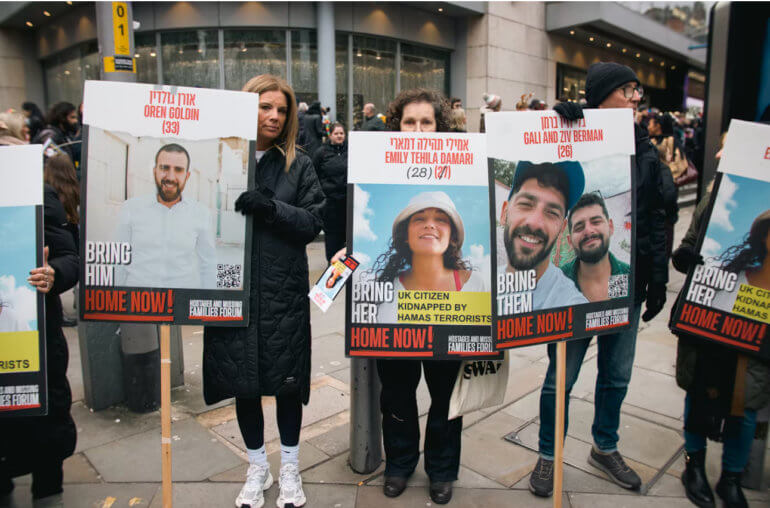
Let My People Go, But At What Price?
Dear Jew in the City,
With the pending hostage deal, does Jewish philosophy discuss if we should save lives if it means letting dangerous people free and sacrificing more lives?
Thanks,
Daniel
Dear Daniel,
Thanks for your question. This is indeed a topic of conversation, but there are a lot of moving parts and no clear consensus. Let’s take a quick look.
Many readers are probably familiar with the opinion of the Rambam that pidyon shevuyim, redeeming captives, is the most important mitzvah of all, taking priority even over feeding the poor (Hilchos Matnos Aniyim 8:10). So important is this mitzvah that even funds collected to build a shul, which are usually untouchable, can be diverted for this purpose (8:11).
But consider the famous Mishnah (Gittin 4:6) that teaches that captives should not be ransomed for an exorbitant sum, for the good of the community. The reason for this is because it provides bad actors with motivation to kidnap Jews. This ruling is brought down in Shulchan Aruch as practical halacha (YD 252:4). However, there is a difference of opinion as to whether this rule applies when the captive’s life is in imminent danger. In such a case, there are those authorities, such as Tosfos, who would say that any price is payable. (Others, like Ramban, disagree.)
A famous real-life case involves the abduction of the Maharam MiRutenburg, a 13th-century sage who was one of the leaders of his generation. When the Maharam was 70, he was taken captive and imprisoned in France, with Emperor Rudolf I demanding an exorbitant ransom. The Maharam’s students – which included most contemporary rabbinic leaders – were willing to raise the amount demanded because he was considered necessary for the community as a whole. Nevertheless, the Maharam did notallow them to do so, knowing that this would only encourage the corrupt secular authorities to kidnap more rabbinic leaders. He spent seven years in prison, where he ultimately died.
This, however, is not the case in war. When it comes to prisoners captured in war, it is prohibited to give in to enemy demands. This is because small concessions embolden the enemy to demand larger things (Eiruvin 45a).
There is plenty of precedent for our preferred approach to rescuing captives in wartime. Perhaps the most famous is when Avraham’s nephew Lot was taken prisoner during the war of the kings (Genesis 14). What did Avraham do? He didn’t offer a ransom. Rather, he saddled up, knocked heads and rescued his captive.
Then there’s the incident in Numbers 21 in which the king of Arad took some captives – or possibly just one captive. But Moshe didn’t ransom them (or her). Rather, the Jews went in, knocked heads and saved their captive(s).
Finally, there’s the example of King David. In I Samuel 30, the nation of Amalek raided the city of Ziklag and abducted the women. King David didn’t negotiate with them. Rather, he pursued them, knocked heads and rescued the captives.
Do you detect a pattern?
We see that this pattern was upheld earlier in the history of the State of Israel. Among the many examples one could give, I’ll share two famous ones: (1) In 1972, members of the Israeli Olympic team were taken hostage in Munich by Palestinian terror group Black September, who demanded the release of 234 prisoners in Israeli jails. Israel said quite clearly that they wouldn’t negotiate with terrorists, period. As you may be aware, this incident ended with the infamous killing of the hostages. (2) In 1976, Palestinian terrorists took hostages in Uganda, demanding the release of 50+ Palestinians held in Israel and elsewhere. This resulted in the famous “Raid on Entebbe.” Israel refused to capitulate to terrorist demands and, despite some casualties, Israeli forces rescued 102 hostages.
But things have gotten a lot more complicated in recent decades. Consider the case of Gilad Shalit, an Israeli soldier who was abducted in 2006. Initially, his abductors were willing to provide information about Shalit in exchange for the women and minors held in Israeli prisons. Instead, Israel sent ground forces to look for him. Later, the terrorists demanded the release of an additional 1,000 prisoners. Israel initially rejected this offer as well.
By 2009, Shalit’s captivity had become a cause célèbre in Israel, with some advocating meeting Hamas’ demands and others opposing any release of terrorists. In 2011, Shalit was ultimately released, in exchange for 1,027 prisoners. One of those released in exchange for Shalit was Yahya Sinwar, who would go on to mastermind the October 7 attack on Israel.
So why did the Israeli government pay such a hefty ransom for Gilad Shalit? Rabbi Shaul Yisraeli, a member of the Chief Rabbinate, made an interesting point: the State of Israel depends on soldiers risking their lives for the nation. They’re not going to do this if they don’t feel that the nation has their backs. It’s in everyone’s best interest that soldiers are confident that the country will work to rescue them from captivity.
So, there seems to be a balance that must be made between the imminent threat to the hostage and a greater threat down the road that’s only a possibility. Before speaking in absolutes, we should remember the words of former Ashkenazic Chief Rabbi Yona Metzger: if you don’t have all the facts of a particular case, it’s impossible to take a definitive halachic position. Each case is going to be different.
If you found this content meaningful and want to help further our mission through our Keter, Makom, and Tikun branches, please consider becoming a Change Maker today.







